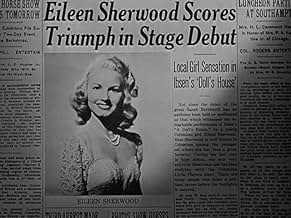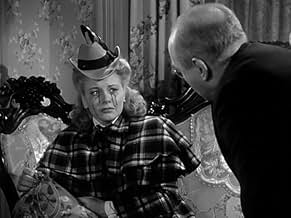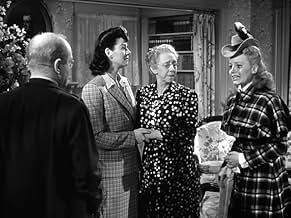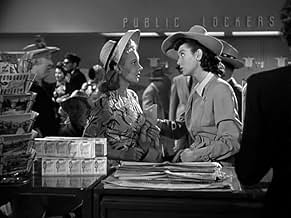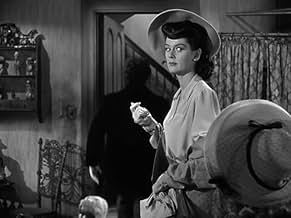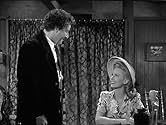CALIFICACIÓN DE IMDb
7.0/10
1.9 k
TU CALIFICACIÓN
Agrega una trama en tu idiomaTwo sisters move from Ohio to New York with hopes of stardom.Two sisters move from Ohio to New York with hopes of stardom.Two sisters move from Ohio to New York with hopes of stardom.
- Dirección
- Guionistas
- Elenco
- Nominado a 1 premio Óscar
- 2 premios ganados y 1 nominación en total
Jeff Donnell
- Helen Loomis
- (as Miss Jeff Donnell)
George Adrian
- Cadet
- (sin créditos)
Kirk Alyn
- Portuguese Merchant Marine Cadet
- (sin créditos)
Don Barclay
- Drunk
- (sin créditos)
Richard Bartell
- Lothario in Bus Terminal
- (sin créditos)
Opiniones destacadas
Ruth McKenney's series of autobiographical articles about siblings from Columbus, Ohio relocated to wacky Greenwich Village was initially turned into a play before this movie version (it later went back to the stage as the musical "Wonderful Town", winning a Tony award for Rosalind Russell), and in 1955 was filmed again as "My Sister Eileen" with the songs. Russell appears here as Ruth (the smart, savvy sister who longs to be a writer) and Janet Blair is sister Eileen (the pretty blonde with hopes of becoming an actress). They move into the noisiest hovel in New York, with a steady stream of foot-traffic and neighbors who barge in without knocking. Some of these characters are colorful, though the comic craziness is pitched a little high, and everyone overacts (cheerfully). Russell (who got an Oscar nomination for her dryly bemused performance) sports an awful potato-chip hairstyle which must have been all the rage in 1942; her double takes and facial exaggerations are often very funny, and she plays well off Blair (they take turns playing the jester and the straight-face). Is it ridiculous and over-the-top? Absolutely. But when the results are this friendly, it's useless to complain. **1/2 from ****
Though this appears to have been filmed entirely on a sound stage, the feel of the original stories comes through. This is the Village as it has been as long as I've lived here.
Please note: I was not born when this movie came out. But maybe my mother, a writer, saw it and decided ti was for her. When I was a child we lived a few blocks from where the stories were set. And for the last decades, I have lived maybe three blocks from there. And how it has changed! And how much for the worse: Rich people, high rents and buying (who'd heard of buying an apartment in 1942?!) Noisy clubs ...
Janet Blair is fine as the title character. Rosalind Russell is very good as her sister Ruth. (The real Ruth, who wrote the stories, married Nathanael West and died tragically at a young age.) Russell is sort of like her Sylvia Fowler character in "The Women." But we can see hints of the broad style that was to come and was to sink her by the time of "Auntie Mame." George Tobias is fun as the girls' fast-talking artistic landlord. Without knowing it at the time, I rented my first Manhattan apartment from the man on whom this character was based. That was 30 years later.
Brian Ahern is OK as the male lead. He's a little stuffy, but he's meant to be. In fact, his character is insufferable. Why Ruth is drawn to him is not made clear.
I loved seeing the organ grinder near the end. I remember them on nearby Waverly Place a decade later when I was a small child! This gives a better view of the Village than any other commercial movie I can think of. It's fun and definitely is recommended..
Please note: I was not born when this movie came out. But maybe my mother, a writer, saw it and decided ti was for her. When I was a child we lived a few blocks from where the stories were set. And for the last decades, I have lived maybe three blocks from there. And how it has changed! And how much for the worse: Rich people, high rents and buying (who'd heard of buying an apartment in 1942?!) Noisy clubs ...
Janet Blair is fine as the title character. Rosalind Russell is very good as her sister Ruth. (The real Ruth, who wrote the stories, married Nathanael West and died tragically at a young age.) Russell is sort of like her Sylvia Fowler character in "The Women." But we can see hints of the broad style that was to come and was to sink her by the time of "Auntie Mame." George Tobias is fun as the girls' fast-talking artistic landlord. Without knowing it at the time, I rented my first Manhattan apartment from the man on whom this character was based. That was 30 years later.
Brian Ahern is OK as the male lead. He's a little stuffy, but he's meant to be. In fact, his character is insufferable. Why Ruth is drawn to him is not made clear.
I loved seeing the organ grinder near the end. I remember them on nearby Waverly Place a decade later when I was a small child! This gives a better view of the Village than any other commercial movie I can think of. It's fun and definitely is recommended..
Rosalind Russell was one of the finest comediennes in the American movies, and this in a period which saw the likes of Claudette Colbert, Carole Lombard, Jean Arthur, Ginger Rogers, Irene Dunne, Katharine Hepburn and others. Russell was a rarity: though all the others often played dizzy women, in her comedies, Russell always played smart, hard-edged career women (the exception was her first major comedy role, as the catty Sylvia in THE WOMEN).
At a time when HANNAH TAKES THE STAIRS is set to open, with its lackadaisical heroine pursuing a writing career as she tries to make sense of her romantic entanglements, it behooves us to remember MY SISTER EILEEN, which (when it was filmed in 1942) is the prototype, as the two Sherwood sisters (Ruth, played by Rosalind Russell, and her younger sister Eileen, played by Janet Blair) come to New York City to try their hands at writing (for Ruth) and acting (for Eileen). The slapstick annoyances, the charmingly maladroit Greenwich Village denizens (part ethnic, part "bohemian"), the stereotypical romantic encounters, all make for a charming entertainment. In the wake of the sexual frankness of HANNAH TAKES THE STAIRS, MY SISTER EILEEN might seem dated, but it's a lovely reminder of the wit and the humor of the generation growing up during World War II, when women were (again) finding new possibilities in the workplace, but still had the same problems finding proper dates.
At a time when HANNAH TAKES THE STAIRS is set to open, with its lackadaisical heroine pursuing a writing career as she tries to make sense of her romantic entanglements, it behooves us to remember MY SISTER EILEEN, which (when it was filmed in 1942) is the prototype, as the two Sherwood sisters (Ruth, played by Rosalind Russell, and her younger sister Eileen, played by Janet Blair) come to New York City to try their hands at writing (for Ruth) and acting (for Eileen). The slapstick annoyances, the charmingly maladroit Greenwich Village denizens (part ethnic, part "bohemian"), the stereotypical romantic encounters, all make for a charming entertainment. In the wake of the sexual frankness of HANNAH TAKES THE STAIRS, MY SISTER EILEEN might seem dated, but it's a lovely reminder of the wit and the humor of the generation growing up during World War II, when women were (again) finding new possibilities in the workplace, but still had the same problems finding proper dates.
The film begins in Columbus, Ohio and young Eileen has visions of stardom on the stage--though she only has worked in community theater. Her older sister, Rosalind Russell, is an aspiring writer and they agree to both go to New York to seek fame and fortune. Along the way, they meet a bazillion crazy characters who wander into their basement apartment faster than is humanly possible. And, yes, I truly do mean wander into the apartment. It's like Grand Central Station in there and after a while the gimmick just doesn't make sense. Subtle it ain't!
MY SISTER EILEEN is a screwball comedy that is very, very aware that that is exactly what it should be. While often cute and enjoyable, all too often the film seems to think that by being too loud, too chaotic and too goofy, it will be a successful film. Personally, I enjoyed it but wish they'd perhaps slowed the whole thing down and tried for at least some subtlety and style. It made the pacing of ARSENIC AND OLD LACE and BRINGING UP BABY seem absolutely slow by comparison!! Throughout this film, whenever the action seems to slow, the film makers seem to just randomly toss characters into the mix with the instructions "act kooky"--sometimes it works and sometimes it doesn't. As a result, it's a very hit or miss production. However, fortunately, the film ends on a very high note with a surprise (and funny) cameo appearance. I won't say more--it might spoil the fun.
Overall, it's a good time-passer and a decent film, but don't expect magic.
MY SISTER EILEEN is a screwball comedy that is very, very aware that that is exactly what it should be. While often cute and enjoyable, all too often the film seems to think that by being too loud, too chaotic and too goofy, it will be a successful film. Personally, I enjoyed it but wish they'd perhaps slowed the whole thing down and tried for at least some subtlety and style. It made the pacing of ARSENIC AND OLD LACE and BRINGING UP BABY seem absolutely slow by comparison!! Throughout this film, whenever the action seems to slow, the film makers seem to just randomly toss characters into the mix with the instructions "act kooky"--sometimes it works and sometimes it doesn't. As a result, it's a very hit or miss production. However, fortunately, the film ends on a very high note with a surprise (and funny) cameo appearance. I won't say more--it might spoil the fun.
Overall, it's a good time-passer and a decent film, but don't expect magic.
It's a circus, but you don't need an admission ticket. You can even peek in from the street and catch all the antics on your way to work. It's Ruth and Eileen's sub-level flat, and rents for only $48 a month with open grillwork onto a chaotic Greenwich Village street scene. Are these two ambitious Mid-western sisters ready for a pro-football player who sleeps over, a fast-talking landlord who paints like a Dodo bird, and a mysterious stranger who walks in and refuses to leave, Then there's the battalion of Portuguese naval cadets who mistake the flat for a dance studio. It's all part of this wacky, fast-paced take on Life in the Big City.
It's all good, innocent fun of course with a tempo that seldom falters, and when things do slow, there's always an underground jolt to mix it up again. Naturally, Rosalind Russell as the caustic older sister gets all the good throw-away lines, while Janet Blair as Eileen gets all the wolf whistles. Then there's the assorted characters-- Gordon Jone's trademark good-natured galoot, George Tobias' fractured ethnic type, and Chick Chandler's silent stranger more creepy than humorous. And, of course, no urban scene of the day would be complete without the bulldog-face of Donald McBride as the ever cranky cop. Together, they turn the flat into a stopover on the way to the funny farm. I expect more than a few Mid-Westerners packed up for New York hoping to get a share of madcap city life.
On a more serious note, the movie was made at a time when the "common touch" was being celebrated in popular culture. After all, it would take a combined national effort to defeat the Axis powers. So, it's not surprising that many movies celebrated the America of the "melting pot", complete with ethnic types, blue-collar characters, and frequent references to Brooklyn, the symbol of the melding.
Anyway, it's still a fun movie even if some skits do strain a bit. I guess the moral is that no city is too big for the talented. And especially, for the shapely. Then too, make sure to stick around for a very last scene that could not be more inspired or appropriate.
It's all good, innocent fun of course with a tempo that seldom falters, and when things do slow, there's always an underground jolt to mix it up again. Naturally, Rosalind Russell as the caustic older sister gets all the good throw-away lines, while Janet Blair as Eileen gets all the wolf whistles. Then there's the assorted characters-- Gordon Jone's trademark good-natured galoot, George Tobias' fractured ethnic type, and Chick Chandler's silent stranger more creepy than humorous. And, of course, no urban scene of the day would be complete without the bulldog-face of Donald McBride as the ever cranky cop. Together, they turn the flat into a stopover on the way to the funny farm. I expect more than a few Mid-Westerners packed up for New York hoping to get a share of madcap city life.
On a more serious note, the movie was made at a time when the "common touch" was being celebrated in popular culture. After all, it would take a combined national effort to defeat the Axis powers. So, it's not surprising that many movies celebrated the America of the "melting pot", complete with ethnic types, blue-collar characters, and frequent references to Brooklyn, the symbol of the melding.
Anyway, it's still a fun movie even if some skits do strain a bit. I guess the moral is that no city is too big for the talented. And especially, for the shapely. Then too, make sure to stick around for a very last scene that could not be more inspired or appropriate.
¿Sabías que…?
- TriviaThe movie is based on the real-life experiences of Ruth McKenney, and her sister Eileen. In 1934, Ruth and Eileen McKinney moved to New York from Columbus, Ohio. They rented a $45-a-month basement apartment at 14 Gay Street in Greenwich Village, above the Christopher Street subway station. Ruth wrote about their eccentric neighbors and the trials of living in a basement apartment in her column titled, "My Sister Eileen," which was published in "The New Yorker" (called "The Manhatter" in the movie). As seen in the film, "The New Yorker" editor Harold Ross was at first reluctant to publish Ruth McKinney's columns, preferring to keep his magazine a "High Society" publication, but he eventually relented. Ruth's columns were gathered in a book, "My Sister Eileen," which was published in 1938. Eileen McKinney moved to Los Angeles, where she married novelist and screenwriter Nathanael West (author of the perennial Hollywood novel, "The Day of the Locust"). Unfortunately, Eileen McKinney and Nathanael West were both killed in a car accident in Los Angeles on December 22, 1940, only four days before they were scheduled to attend the Broadway opening of the play, "My Sister Eileen." Ruth McKinney died in 1972 at age 60.
- ErroresWhen Bob puts Ruth in the taxicab outside of the police station, the shadow of the boom mic can be seen moving across the hood of the cab.
- Citas
'The Wreck' Loomis: [holding an iron] Which way do you want the pleats turned?
Ruth Sherwood: Toward Mecca.
- ConexionesReferenced in Acropolis Now: My Sister Aphroula (1990)
- Bandas sonorasRamblin' Wreck from Georgia Tech
(uncredited)
Written by Billy Walthall, Frank Roman, Charles Ives and Michael Greenblatt
Sung by Gordon Jones
Selecciones populares
Inicia sesión para calificar y agrega a la lista de videos para obtener recomendaciones personalizadas
- How long is My Sister Eileen?Con tecnología de Alexa
Detalles
- Fecha de lanzamiento
- País de origen
- Sitios oficiales
- Idioma
- También se conoce como
- My Sister Eileen
- Locaciones de filmación
- Productora
- Ver más créditos de la compañía en IMDbPro
- Tiempo de ejecución1 hora 36 minutos
- Color
- Relación de aspecto
- 1.37 : 1
Contribuir a esta página
Sugiere una edición o agrega el contenido que falta

Principales brechas de datos
By what name was Los caprichos de Eileen (1942) officially released in India in English?
Responda

